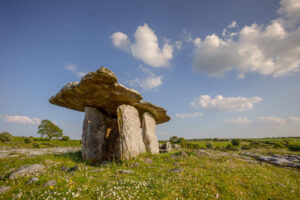


The Historical Importance of the Dolmens
Dolmens are ancient megalithic structures typically made of large standing stones topped with a horizontal capstone. These structures, dating back to the Neolithic period (around 4000–3000 BCE), are found across Europe, Asia, and parts of Africa. They are believed to have served as burial chambers or ceremonial sites, marking them as significant cultural and religious monuments of early human civilization.
The name “dolmen” comes from the Breton language, with “dol” meaning table and “men” meaning stone, which reflects their table-like shape. Most dolmens consist of two or more vertical stones (orthostats) supporting a large, flat horizontal stone. While their exact function remains somewhat mysterious due to the lack of written records from the time, archaeologists believe dolmens were connected to burial rituals, community gathering, and the commemoration of ancestors. The human remains found in many of these dolmens, often accompanied by pottery, tools, and jewellery, suggest they played a role in the burial of important individuals within ancient societies.
The historical importance of dolmens lies in their reflection of early humans’ engineering capabilities and spiritual practices. They demonstrate sophisticated knowledge of construction, as well as the cultural value placed on honouring the dead and creating lasting monuments. Moreover, they provide insight into the social and religious structures of prehistoric communities, hinting at the existence of an organized society with shared belief systems and communal labour efforts to erect these massive structures.
Dolmens in Ireland
Ireland is home to numerous dolmens, also known locally as “portal tombs,” which are among the oldest man-made structures in the country. These ancient monuments are scattered across the Irish landscape, mostly concentrated in regions with rich archaeological history. Some of the most famous dolmens in Ireland include:
Brownshill Dolmen in County Carlow, renowned for having the heaviest capstone in Europe, weighing an estimated 100 tons.
Proleek Dolmen in County Louth, a picturesque site near the Cooley Peninsula.
Kilmogue Dolmen in County Kilkenny, with its distinctively large portal stones and capstone.
Legananny Dolmen in County Down, located in a dramatic rural setting and characterized by its tall, slender portal stones.
However, one of the most iconic and best-preserved dolmens in Ireland is Poulnabrone Dolmen.
Poulnabrone Dolmen
Situated in the Burren, a striking karst landscape in County Clare, Poulnabrone Dolmen is perhaps Ireland’s most famous dolmen and an important archaeological site. The name “Poulnabrone” translates from Irish as “the hole of sorrows,” hinting at its historical role in burial and commemoration.
This portal tomb, standing around 5,000 years old, consists of two tall portal stones supporting a large flat capstone, with additional upright stones forming a chamber. Excavations in the 1980s revealed the remains of at least 33 individuals, dating from 3800 to 3200 BCE, buried beneath the dolmen. The findings also included personal items such as stone axes, pottery, and quartz crystals, which were likely placed as grave offerings.
Poulnabrone Dolmen’s historical significance goes beyond its function as a burial site. It represents the architectural ingenuity of the Neolithic people, who had no advanced tools or machinery but managed to create structures that have endured millennia. Additionally, its location in the Burren adds to its mystical aura. The surrounding landscape, characterized by its barren, rocky limestone formations, provides a dramatic backdrop that highlights the dolmen’s significance as a spiritual or ceremonial site.
Poulnabrone Dolmen Tours with Newgrange Day Tours
For those interested in visiting Poulnabrone Dolmen, Newgrange Day Tours offers private luxury tours to the site. These tours provide a unique and immersive experience, allowing visitors to explore the ancient monument in comfort and style. Operated by experts in Irish history and archaeology, the tours offer a deep dive into the significance of the dolmen, its archaeological discoveries, and the broader context of Neolithic Ireland.
Unlike large group tours, Newgrange Day Tours caters to private groups, making the experience more personalized and intimate. Travelers can enjoy the scenic drive through the Burren in a luxury car, with opportunities to stop and appreciate the dramatic landscapes and other nearby historical sites, such as the Cliffs of Moher and the Aillwee Burren.
Poulnabrone Dolmen is a must-see destination for anyone interested in Ireland’s ancient past. As one of the most iconic megalithic monuments in the country, it offers a rare glimpse into the burial practices and spiritual life of Ireland’s Neolithic people. Combining a visit to this historical site with the comfort of a luxury tour ensures an unforgettable journey through Ireland’s rich and mysterious past.


